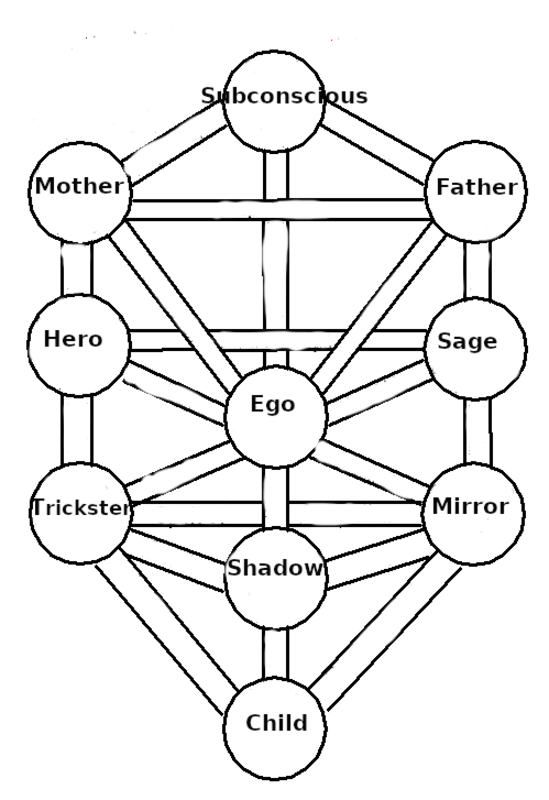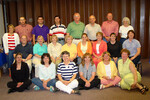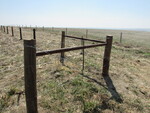Posted date: Feb 2, 2022
Edited
by: Dianna Padgett
737 Views
10 – Child, is the innocent, the one that has to live in this chaotic realm and pass through it. She is the Soul that knows the other characters that live here, how to get along with them, the hiding places, and, like a child, knows who to trust and who to take with a grain of salt. In time she recognizes that she is the center of the Subconscious. All the other players in this realm have her and only her in their hearts.
9 – Shadow, is the suppressed, the unbalanced, the hungry. Some are scary, some are nice. Some are a result of things that have happened to the Child and some are born of things so beyond her comprehension that she tiptoes around them, getting to know them a little bit at a time. As the Child spends more time with them she learns the cause of their angst and, with the help of others around her, faces their pain and finds a way to embrace their strengths.
8 – Trickster sometimes makes sense but mostly jumps out and says ‘Boo’ and laughs. But the Trickster is the one that brings wonderful surprises as well, flowers and magic and music that she can dance to. She learns to always know where he is and to expect the unexpected. She comes to realize that the Trickster is trying to tell her that something is wrong and by dancing to Tricksters music she can hone in on the problem and find a way to fix it.

6 – Ego is like the child’s bodyguard. He’s always at the door letting only the safe things in and finding ways to keep out what may be harmful to her. She learns that he isn’t very smart but if she talks to him he starts to understand needs and fears. Ego becomes her outer mask, one that can be changed as the need arises and as she grows in confidence and wisdom.
5 – Hero makes her feel strong, like she can do anything. Hero fights the monsters. Hero is who she wants to be when she grows up. Hero protects her and warns her of danger.
4 – Sage is a strange one. Always telling stories. She makes wonderful treats and doesn’t tell the Child ‘eat up, it’s good for you’ even though they are. They just taste good. Child and Sage go for long walks to see the landscape and look at stars. They meet interesting people, seemingly by chance. But Child always has wonderful dreams of these new people. Child tries to spend a lot of time with Sage but sometimes she is hard to find.
3- Mother gives Child hugs. Mother explains the ways of the world and is practical and is sometimes mean but in a good way. “Clean up this mess so you have room to dance.” “Don’t eat too much sweets, eat some veggies too, they’re good for you.” She means well. Mother gives much love, in a practical way.
2 – Father takes Child on adventures!! He is passionate and joyful and wants show her Everything! They go to see wonderful places she’s never seen before. He occasionally wants to take her where she’s a little afraid to go. “Maybe you’re just not old enough for that yet” he says. “But we will go there sometime. It’ll be great.”
1 – Subconscious is the name of this country. Child has learned to spend a little time with everyone. She will discuss what she has learned from one with another, just to get a different perspective. Sometimes they have family meetings. They don’t usually go well. Too many strong personalities in one room. The Child soon learns that it’s her job to keep the peace.
Now to the process.
10 – Child.
The Child is the Soul in Malkuth that has the where-with-all and the courage to say “Who am I.” This is not a question. It is a statement of intent. With this spark of Will the Universe turns to focus on this remnant of the Original One and says, “Look.”
As with the Original One, the Child becomes the Observer and the Observed. The Observer must remain Objective and not be affected by what it sees, but be, as an eye, a conduit. The Observer takes in what is there to be observed and disburses the images, giving to the mind what the mind can use and giving to the heart what the heart needs.
It delegates to the ever evolving body the sensuous variations of vibrations bombarding it from every direction. It teaches it what frequencies are available to the ‘physical’ body in this narrow range of frequencies the body calls home. What does the rose smell like? How does the sun feel on a spring morning? What does the vast sea look like from the safety of shore? How does it feel to be tossed about in it with no shore in sight? The Child says ‘Who am I’ but the One says “Experience Me so I know who I am”.
The most important thing the Child needs to be is unaffected. She needs to be a conduit. The logical mind is like a hammer. It takes a bit of information and smashes it into a million pieces to see what it is. This smashing sends vibrations into every part of the inner workings of the individual and leaves a mark. The Child is affected by thinking. The Child is not affected by being. So, find ways to stop thinking.
Take up a hobby. Sewing, gardening, woodworking, collecting stamps, painting, whatever. Jung built a stone house. The total focus on your chosen bliss will free the mind from processing extraneous data and allow the subconscious to play out it’s interactions without being constantly dominated by the overlord Logic. Even if your hobby is an intellectual one, the mind is so consumed by the project that the Subconscious is given the freedom it needs to stretch and breathe in the infinite possibilities that pass through the now distracted mind and body.
Meditation. The goal of meditation is to stop thinking. Start by getting into a position you can stay in for a long period of time and repeat something over and over: a prayer, a chant, a word, a string of nonsense sounds, anything. With time and practice your mind will shut down and you will be in a state of just being. It’s more refreshing than sleep and afterwards thoughts will surface that were born in the unbounded subconscious that add a bit of clarity to the question ‘Who am I’. You can use a lit candle instead of a chant, or an image to focus on. The trick is to focus on something that does not create a dialogue in your mind. If a dialogue begins then let it play out but ignore it, like a conversation across the room. Simply choose not to participate. It will pass.
Listen to music. Really listen. This is not putting on music as a background to whatever else you are doing. Sit or lie down and focus only on the sound for at least half an hour. Let the melody and rhythm wash over and through you. Feel your mind and body dance to its fluctuations. Or, if you can, dance. Allow the sound to move directly from your ear to your feet and the rhythm that hits your body to have instant reflection in your movement. If you have a big enough space, dancing is the most freeing thing you can do. And it hones that empty conduit necessary for the flow of As Above, So Below.
Write. Likewise, write so the words flow from your subconscious to your fingers. Whenever I think too much about what I write it comes out wrong. Write a journal or a letter. Write about something that is troubling you or that you love. Point is, don’t think about it. Just open that vein and start typing.
The child is innocent, and as an innocent is not hampered by fear or logic or greed. The child is immortal because she has no concept of death. She can do or be anything. The Child is the true hero because she has no motive. She acts spontaneously. The Child, the Hero and the Fool are all the same. Your inner Child must always be nurtured and protected because to lose the child will be to lose everything. How to nurture the inner child? Give her time to play. Don’t lecture her with plans for the future or analysis of the past. Try to see through her eyes, smell the scents that excite, and feel the plethora of textures that are dulled by time and purpose. It’s only by being your child self that you can see clearly.
Funny thing about seeing, you only see what you are. A bird or a bug sees a tree and they see shelter and food. A hiker sees a tree and sees shade. A painter sees a tree and sees color and form. A builder sees a tree and sees lumber. So the Child comes to the collateral reality of seeing and must deal with the Shadow.
9 – Shadow
To understand the Shadow one must first understand duality. Everything has two sides. The first duality, Observation, has the Observer side and the Observed side. Observer is active, Observed is passive. But that was simple. There was only the I Am and the What Am I; no dysfunctional childhood home, no peer pressure, no cultural bigotry, no deformity, no pain, no hunger. The Child self, as observer, has a lot of muck and mire to wade through. The discordant notes that mar the symphony need to be identified and the musicians retrained.
The human child first encounters the Mother. The child is a helpless little thing and its needs are nurture and love, acceptance. The child’s mother is a human being and never perfect. Even a near perfect one might sleep through the night out of sheer exhaustion and miss a feeding. The babe cries itself to sleep and certainly survives but felt its first pain and hunger. Mother then has two sides. The warm Mother with milk that the baby needs and the absent Mother. If the Mother becomes increasingly distant and cold then the rift between need and reality increases and ingrains itself as a Shadow figure in the subconscious. Likewise if the Mother is too much present as the child ages and no longer needs her constant care then a different Shadow figure appears. When there is a great divide between what the child needs and what the reality provides then the need personifies as a hungry beast within the subconscious. My own Mother was rather cold and distant. My conscious mind did the best it could but my Mother Shadow worked against my needs. I wasn’t as caring to myself as I could be. I didn’t feel myself worthy to pick the best men for my partners. I internally belittled myself over minor failings. How to deal with this Shadow? We are already equipped with a Mother. Love and nourishment is part of the structure of the Whole. The structure couldn’t hold without harmonious interaction. We need air so there is air to breathe. We need water so it falls from the sky. But how to breathe and drink when you don’t feel worthy to accept it?
There is the answer, peeking out, Freudian-like, from the question. To Feel. Talking about it may uncover the problem but it is only feeling that will resolve it. First you need to confront the problem. Why do I feel the way I do? What is the problem, really? I’m not good to myself because I don’t know how it feels for someone to be good to me. Just as you have a Child Self, you have a Mother Self. Feel your Mother Self picking up your Child Self to give it love and support. It may seem only imagination at first. But that’s fine. Learn by doing. In time, or with hypnotic-therapy, you can soon feel what the Mother Self feels, that caring and concern. Feel what the Child Self feels, the protection and nourishment. Of course you will feel silly at first because the Mother Shadow resents the intrusion. Even though she’s distant she still demands your respect. The more you do it, the weaker the Shadow becomes. Your need becomes balanced with your nurture. You can absorb the Mother Shadow and learn her need to be true to herself, but tempered with the empathy to understand and the needs of those around her. The Ego, the guard at the door, will need to understand that ‘Mother’ no longer means rejection but comfort and she is welcome any time. This may take some persistence on the Child’s part as well because Ego is, after all, a bear of very little brain. But be patient and continually seek out the inner Mother. The Ego will get the message and not repel the aspects you come to terms with.
The Shadow is not always ‘bad’. It may be that the shadow has become so strong that it overwhelms the conscious mind and had trapped the honorable, but weakened aspect in the subconscious. Shakespeare’s Richard III is an excellent rendering of how that would work. Next time you read or watch this play, see it from this perspective to gain more insight.
How can this Shadow be healed? A child is born deformed. A Shadow is born from pain, rejection and a recognition of being different. The inner Child, if given the freedom to explore his subconscious realm, hears quips of bitterness, smells the rancid fumes of anger from the Trickster. Checking the Mirror he sees more and more his physical deformity and less and less the beauty of his pure heritage. He checks with Ego, the guard at the door, “Can’t I have friends?” “No! They will hurt you by saying mean things. You know how children are. And you’ll feel different than them. I can’t have you feeling pain. It’s ok, you’re better than them. You’ll show them in time. You’re smarter than them.” Ego’s been perverted by the King Shadow. Child’s home is starting to fall apart.
What does Sage say? “Every Shadow contains within itself the seed of its own destruction. The goal is to reunify the two aspects before the Shadow can destroy everything. The good King is the one that has the respect of all men, and the strength and power to bear the great weight of the kingdom. Merged together the King is honorable and the kingdom is secure. Torn apart by pain the King is a selfish manipulator and doomed to fail and the kingdom falls. This must be achieved on multiple fronts.
First go to the torn and weak Shadow that resides here in the subconscious. Feel his weakness. Feel his despair in not being his whole vibrant self. Let him know you believe in him and his deformities can not hinder his ability to be a good king. This is very important.
Then tell Ego that you are strong enough to take what others say and they will not hurt you. They will become friends in time. Feel Ego's respect for, and need to protect, the Child. And feel the Child’s confidence in learning to be vulnerable until matters are resolved because he is being guarded by an Ego that knows his orders.
Tell Trickster not to dwell on the pain and rejection, it’s not important. The problem is being resolved. Thank him for his warnings and let him know you appreciate any further insight he may have.
Ask Father Self to spend time with Hero/King Self to show him other ways to regain his self esteem, joy in hope and hope in tenacity. Feel Father's passion for life and pride in Hero/King. Feel the infinite possibilities that flood through him. Feel Hero fill up with the strength and purpose that Father imparts to him. “Why do I rail on thee, Since thou, created to be awed by man, Wast born to bear?”2
And send Mother Self in to ease his pain and comfort him with love. Feel her arms around him and her love for him like a warm fire healing his weakened self. Feel Hero/King grow stronger. With time and persistence a tragedy can be avoided and the Hero/King self will regain his position of strength.
Each Shadow you confront and work with will give you opportunity to work with other inner aspects. You may need some support from the Hero Self or the Father Self or advice from the inner Sage. Checking the inner Mirror will help gauge how you are doing. All of these will be explored in more detail in upcoming lessons.
1 - The Archetypes and the Collective Unconscious (Jung's Collected Works) by C.G. Jung,
2 - Richard II Shakespeare Act 5 scene 5







